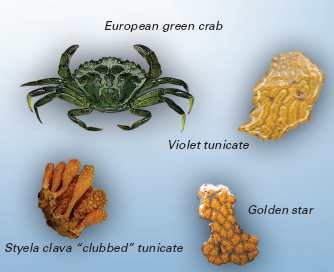 So, here's a statement you will probably almost NEVER hear....:
So, here's a statement you will probably almost NEVER hear....:- Darn those invasive echinoderm species !!
What Is an Invasive Species?
There is a very elaborate exploration of this topic on many web pages, including Wikipedia and blogs, such as Invasive Species Weblog and of course, large national organizations such as NBII.
But the short version is that introduced species are those which are not endemic (i.e., brought from outside its natural range) that have unanticipated ecological effects that have deleterious (=bad) economic, agricultural or other environmental impacts.

(from Fisheries & Oceans Canada)
Above are examples of different introduced marine species to the North Pacific of Canada (among other places). Basically different marine invertebrates that have been spread via various ways to areas WAY outside their natural range. Once introduced they have NO natural ties to the ecosystem to their new home.
No Predators. No close ecological relationship with prey. So, they go crazy and cause all kinds of problems!
To illustrate this point quickly..Think of the human equivalent of an alien invasive....
 Obviously, one is pretty bad..but more then one and running around on Earth? NOT good.
Obviously, one is pretty bad..but more then one and running around on Earth? NOT good.Marine introduced species are brought along and introduced via a variety of ways. But one of the most prevalent ways?? Boat Ballast Water.
Basically, the larvae (i.e., the babies) of various invertebrate animals are picked up from their natural range, carried around the world where the ship goes and then offloads and dumps them into the water!! Here is the larval stage of our subject today....
But here's the thing, a lot of these invertebrates usually have some kind of physiological predisposition for survival. They can usually tolerate wide ranges of salinity, temperature, and etc. They don't always survive for long where they get dumped off.
Why are echinoderms so unusual as introductions??
Echinoderms are usually pretty sensitive to where they live (since they are essentially filled with seawater). They generally don't tolerate freshwater (I have often seen many dead starfish following a lot of rain in California) and echinoderms are pretty fickle when it comes to temperature, water quality, and etc.
So, generally echinoderms are NOT seen as introduced species in the best-known sense. But then, one found a niche....
MEET Asterias amurensis....
 A. amurensis occurs naturally in the sub-Arctic North Pacific, including the Aleutian Islands/Alaska, Japan, Russia and thereabouts. Mostly in shallow-water but can occur down to about 200 meters depth.
A. amurensis occurs naturally in the sub-Arctic North Pacific, including the Aleutian Islands/Alaska, Japan, Russia and thereabouts. Mostly in shallow-water but can occur down to about 200 meters depth. So, this species was essentially transported from the other side of the world!! And miraculously found itself in the cool, temperate waters of Tasmania and South Australia. In an environment VERY similar to its natural range!
So, this species was essentially transported from the other side of the world!! And miraculously found itself in the cool, temperate waters of Tasmania and South Australia. In an environment VERY similar to its natural range!A. amurensis is known for two things which makes for a GRAVE concern to Australia.
1. A. amurensis is VERY fecund. A single female of this species can produce 20 MILLION eggs! Since discovery in the early 90s, this has translated to an estimated 30 MILLION individuals in Tasmanian waters (mostly in the Derwent estuary).

 2. They EAT shellfish. A LOT of them.
2. They EAT shellfish. A LOT of them. (this is not A. amurensis-but it gets the point across. From the MarLin Gallery)
(this is not A. amurensis-but it gets the point across. From the MarLin Gallery)Australia has a number of very successful shellfish (i.e., bivalves) fisheries. Cockles, mussels, scallops. etc. So, a great deal of work has been dedicated towards the study of the ecological impacts.
Among the more significant findings is this study by Hudson et al. that the introduced A. amurensis does NOT induce the natural escape response that the endemic species does! So, the natural ecological behavior to "RUN AWAY" that endemic Australian starfish species have co-evolved with various scallops is absent from the interaction between the introduced A. amurensis when it feeds on Australian scallops!!
Click here to see part 2 of the A. amurensis Invasion we go more into depth with the Invasion!! The role of Taxonomy!! The National Starfish Taskforce!!!! The Response to the Invasion!


"A single female of this species can produce 20 MILLION eggs!"
ReplyDeleteHow many eggs does the average starfish generally produce? Also, are there any estimates as to when this species may have been introduced to Australia? I was wondering how long it might have taken for the population to grow large enough to be initially noticed...
Thanks for the post!
I'll be honest and say that emphasis on this particular fact may have been presented to showcase the reproductive power of this species. Many starfish lay eggs in the millions (although exact numbers are unavailable) but often times, what is important is how many of these actually survive and settle out.
ReplyDeleteIn the instance of A. amurensis-there's a LOT of them..probably more then what is cosidered typical. But that may be natural for this species-which is quite abundant even in its home range.
pt. 2 with questions to more of your answers coming right up!